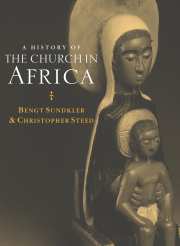Book contents
- Frontmatter
- Contents
- List of maps
- Acknowledgements
- List of abbreviations
- Introduction
- PART I THE FIRST FOURTEEN HUNDRED YEARS
- PART II THE MIDDLE AGES 1415 – 1787
- PART III THE LONG NINETEENTH CENTURY 1787 – 1919
- PART IV THE COLONIAL EXPERIENCE 1920 – 1959
- 11 Continental Panoramas
- 12 Local Perspectives
- 13 North and North-Eastern Africa
- 14 West Africa
- 15 Central Africa
- 16 Southern Africa
- 17 Eastern Africa
- PART V INDEPENDENT AFRICA 1960 – 92
- Notes
- Bibliography
- Name index
- Subject index
16 - Southern Africa
from PART IV - THE COLONIAL EXPERIENCE 1920 – 1959
Published online by Cambridge University Press: 16 September 2009
- Frontmatter
- Contents
- List of maps
- Acknowledgements
- List of abbreviations
- Introduction
- PART I THE FIRST FOURTEEN HUNDRED YEARS
- PART II THE MIDDLE AGES 1415 – 1787
- PART III THE LONG NINETEENTH CENTURY 1787 – 1919
- PART IV THE COLONIAL EXPERIENCE 1920 – 1959
- 11 Continental Panoramas
- 12 Local Perspectives
- 13 North and North-Eastern Africa
- 14 West Africa
- 15 Central Africa
- 16 Southern Africa
- 17 Eastern Africa
- PART V INDEPENDENT AFRICA 1960 – 92
- Notes
- Bibliography
- Name index
- Subject index
Summary
ZAMBIA
Zambia, or Northern Rhodesia as it was then called, was during the 1920s ‘a poverty-stricken backveld Protectorate which only few people could have identified on the map’. The population was entirely rural, many being involved in fishing on the lakes and along the Luapula and the Zambezi. Enterprising pioneers from Malawi, ‘black Scots’ from the East, became store-keepers in the bush and might sell their commodities on such markets as were springing up in connection with the emerging mines. After the years of Chartered Company rule, a ‘Protectorate’ was established in 1924, and in the 1920s copper was discovered, upon which the conditions and the outlook of the country was totally changed. Towards the end of the 1920s four large mines were being developed on the Copperbelt and at each of them a town soon emerged, with a small European and a large African population, with Ndola the main commercial centre. By the 1950s, 120,000 Africans and some 38,000 Europeans worked in the mines. Migrant labourers in their tens of thousands came from the rural communities of Zambia and Malawi, all coming for the very first time to a mine and to the city.
The Africans working in the mines were a floating population, staying for about a year or, if married, for nearly two years.
- Type
- Chapter
- Information
- A History of the Church in Africa , pp. 786 - 845Publisher: Cambridge University PressPrint publication year: 2000



